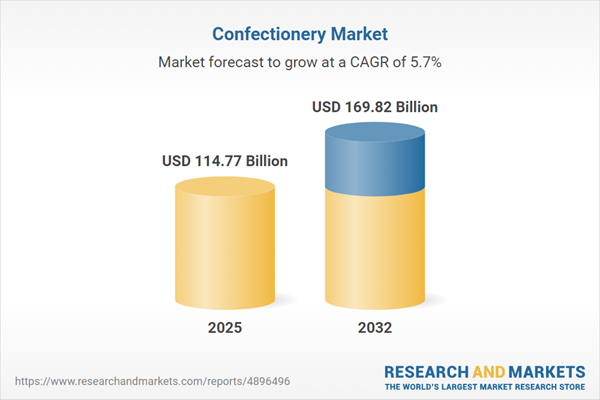Speak directly to the analyst to clarify any post sales queries you may have.
The global confectionery market is experiencing significant transformation as evolving consumer behaviors, technological progress, and tightening regulations push brands to innovate, streamline operations, and rethink growth priorities. Senior decision-makers face a fast-shifting sector where timely, actionable insights underpin strategic advantage.
Market Snapshot: Confectionery Market Size and Growth
The confectionery market expanded from USD 108.63 billion in 2024 to USD 114.77 billion in 2025, with a projected compound annual growth rate (CAGR) of 5.74%. By 2032, the sector is forecast to reach an estimated USD 169.82 billion. Robust expansion is fueled by higher global consumption, ongoing product innovation, and adaptation to consumer-driven retail models. As new trends emerge, companies must recognize and seize opportunities in this dynamic industry to remain competitive.
Scope & Segmentation
- Product Types: The market spans chocolate (including dark, milk, and white varieties), gum, breath mints, and a diverse array of sugar-based confections. Each product category aims to deliver on varied taste experiences and specific customer moments, reflecting changing preferences globally.
- Ingredient Types: Offerings incorporate both conventional sugar and sugar-free choices, such as aspartame, sucralose, and natural sweeteners like stevia. This diversity enables manufacturers to address regulatory shifts and meet the demand for health-conscious alternatives.
- Distribution Channels: Confectionery products are delivered through convenience stores, drugstore and pharmacy chains, supermarkets, hypermarkets, and increasingly through dedicated online retail and global e-commerce platforms. The digital channel growth allows direct engagement and greater market reach.
- Regional Coverage: The analysis covers key regions: the Americas (with a focus on the United States and major Latin American economies), Europe (both Western and Eastern markets), the Middle East, Africa, and Asia-Pacific. Each region presents distinct regulatory environments, logistical challenges, and diverse consumer preferences.
- Leading Companies: Significant market presence is held by Mars, Mondelez International, The Hershey Company, Ferrero International, Nestlé S.A., Pladis Global, Perfetti Van Melle Group, Meiji Holdings, Haribo, and Lotte Confectionery. These companies leverage scale, targeted innovation, and adaptable go-to-market strategies to maintain brand strength.
Key Takeaways for Senior Decision Makers
- Consumer demand for lower-sugar, plant-based, and functional options is rising, making product innovation and agile portfolio management crucial to brand differentiation.
- Pursuing sustainability drives organizations to emphasize ethically sourced ingredients, responsible packaging, and transparent communication across the value chain.
- Digital capabilities such as data-driven marketing and real-time analytics are vital for effective personalization, improved customer loyalty, and enhancing omnichannel sales results.
- E-commerce growth and experiential retail models shift how brands connect with both longstanding and emerging audiences, requiring agile channel strategies and proactive adaptation to evolving consumer paths.
- Investment in research and development, partnerships with ingredient specialists, and advanced supply chain technologies build resilience and allow quick responses to market or supply disruptions.
- Tailored approaches are essential for navigating different regulatory, cultural, and distribution landscapes globally. Flexible market entry and expansion strategies support compliance and customer alignment.
Tariff Impact: Addressing U.S. Tariffs and Supply Chain Implications
Upcoming United States tariffs in 2025 will affect sourcing and overall costs for confectionery players. Market leaders and importers are recalibrating supply networks, renegotiating supplier contracts, and exploring alternative ingredient origins to safeguard profitability. Retailers are adapting by refining pricing tactics and optimizing logistical flows. Manufacturers are also prioritizing reformulation initiatives and maintaining open lines of communication throughout the supply chain to ensure continued business stability and strategic market positioning during the transitional period.
Methodology & Data Sources
This analysis integrates comprehensive primary research, including executive interviews, stakeholder surveys, and site observations, alongside secondary data. Ongoing monitoring and robust analytics tools help model global market scenarios. All intelligence gathering strictly follows ethical and privacy best practices to ensure actionable and reliable results for senior leaders.
Why This Report Matters
- Supports strategic portfolio, channel, and investment decision-making with up-to-date insights on market realities and opportunities within the confectionery sector.
- Provides essential guidance for contingency planning and supply chain resilience by analyzing regulatory challenges and revealing pathways for improved adaptability.
- Offers clear benchmarks and focused insights to support technology adoption and the pursuit of regional growth within ever-changing consumer and regulatory contexts.
Conclusion
Amid market evolution and regulatory complexity, this report empowers senior decision-makers to respond effectively, drive innovation, and enhance resilience across the confectionery value chain.
Additional Product Information:
- Purchase of this report includes 1 year online access with quarterly updates.
- This report can be updated on request. Please contact our Customer Experience team using the Ask a Question widget on our website.
Table of Contents
3. Executive Summary
4. Market Overview
7. Cumulative Impact of Artificial Intelligence 2025
Companies Mentioned
The companies profiled in this Confectionery market report include:- Mars, Incorporated
- Mondelez International, Inc.
- The Hershey Company
- Ferrero International S.A.
- Nestlé S.A.
- Pladis Global
- Perfetti Van Melle Group
- Meiji Holdings Co., Ltd.
- Haribo GmbH & Co. KG
- Lotte Confectionery Co., Ltd.
Table Information
| Report Attribute | Details |
|---|---|
| No. of Pages | 196 |
| Published | October 2025 |
| Forecast Period | 2025 - 2032 |
| Estimated Market Value ( USD | $ 114.77 Billion |
| Forecasted Market Value ( USD | $ 169.82 Billion |
| Compound Annual Growth Rate | 5.7% |
| Regions Covered | Global |
| No. of Companies Mentioned | 11 |









